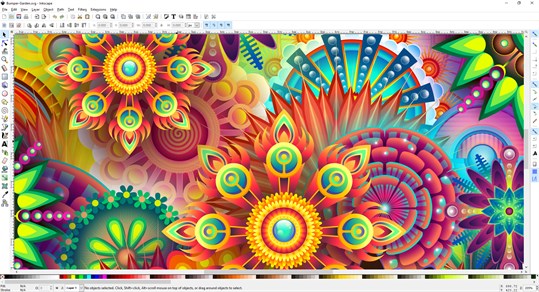

Through its development, other forms of Realism have developed throughout the history of art. The depiction of ordinary and common subjects has long appeared within art, with the Realism movement bringing this style to the forefront. Thus, Realism was used as a vehicle to critique the social and political aspects of society, with artists making use of newspaper printing and mass media to broadcast their work. The combination of these developments added to the rising interest in documenting the current life and society of the 19thcentury.

Realistic inkscape art professional#
Among these were the Positivist philosophy developed by Auguste Comte, in which the study of society was emphasized, the increase in professional journalism that was able to accurately record current events, and the development of photography which was able to exactly reproduce visual images. Whilst Realism was said to directly stem from artists’ desire to present more honest and unidealized views of everyday society, a number of other intellectual developments stimulated its growth. Prior to this movement, the poverty of subjects was rarely included in the moral message surrounding art, with Realism openly emphasizing the challenges of life for the poor within the artworks created. Realism artists began to use common laborers as their prime subjects, as well as ordinary individuals that were engaged in real activities in normal surroundings. Ordinary yet contemporary situations were shown in a truthful and accurate light, with artists including the unpleasant aspects of life to display an honest depiction of what they saw. Working in a time marked by revolution and vast social change, Realism attacked the values of the bourgeois society by portraying regular individuals from all social classes within their artworks. Realism was the first clearly anti-institutional and non-conformist art movement. The Realism Art movement reformed painting and what was thought to constitute art as it replaced idealistic images with real-life scenes, which brought ordinary society closer to the grand subjects which were typically represented in paintings. In the aftermath of the Industrial Revolution, traditional forms of art, literature, and social organization were dismissed on the basis that they had become outdated. This led to unwavering and often horrible portrayals of life and its unpleasant but raw moments. Within the mid-19 th century, Realism focused on how life was socially, economically, politically, and culturally arranged. This anti-Romantic development paved the way for Realism in art, which sought to embrace the aims of modernism through reexamining and overthrowing traditional values and beliefs within society. Realist artists dismissed this within their artwork, as they believed that everyday life and the modern world existed as appropriate subjects for art.

This artistic movement, which was defined by an elevated sense of emotion and intensified drama, typically displayed exotic and mythological figures and grand scenes of nature in a glorified light. Prior to the Realism movement, Romanticism was the reigning style that was used within the creation of art. Joueurs d’échecs (‘The Chess Players’, 1863-1867) by Honoré Daumier Honoré Daumier, Public domain, via Wikimedia Commons Thus, common individuals were suddenly seen as interesting and respectable subjects, with artists beginning to represent the broader society within their works. Following this upheaval, the right to work had firmly been established in France, with this movement depicting the average, working-class population, as well as their current settings and everyday scenes, in a new light. Realism, sometimes referred to as Naturalism, appeared within France during the 1850s, after the 1848 Revolution. The Realism Art movement created artworks that were as realistic as possible, as artists attempted to portray their subject matter in an honest and accurate light without disguising the more unpleasant elements of life. This shift allowed subject matter and scenes to be depicted as they were truly viewed. Widely thought to signify the beginning of modern art, Realism was an art movement that discarded the traditional elements that had previously governed artworks.

7.3 What Is the Favored Subject Matter Within Realism Art?.7.2 What Is a Suitable Realism Art Definition?.3 Notable Realism Artists and Their Artworks.


 0 kommentar(er)
0 kommentar(er)
